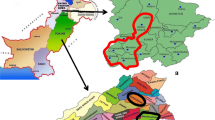Abstract
In India, dengue endemic areas overlap with chikungunya-affected areas and both the viruses are transmitted by same vector, Aedes aegypti — thereby increasing opportunity of co-infection by both viruses. Present study was carried out to understand the DENV–CHIKV infection dynamics during recent outbreaks in eastern India (West Bengal state) and its implication on disease manifestations. Blood was collected from 326 symptomatic febrile patients. Patients’ serum was subjected to serological diagnosis for presence of anti-dengue-IgM, anti-chikungunya-IgM antibodies and dengue-NS1 antigen by ELISA. Viral RNA was extracted, and presence of dengue virus (DENV) and chikungunya virus (CHIKV) genome, their viral load (VL), and serotype among infected patients’ plasma was determined by real-time qRT-PCR. Statistical analysis was performed by using EPI INFO software. DENV and CHIKV were detected in 54% and 33% of symptomatic patients respectively, among whom 23% were harboring both viruses. WHO classified warning signs were detected among 64% DENV patients and 61% DENV–CHIKV double-infected patients. Patients with warning signs always had much higher DEN VL than those without warning signs. Hemorrhagic manifestation and abdominal pain was found in significantly higher frequency among patients with high dengue VL (>10,000 copies/ml). DENV2 was the most predominant serotype among monotypic dengue patients, whereas DENV2–DENV4 combination was most prevalent among patients infected with dual dengue serotypes. This study indicated that DENV–CHIKV double infection and high dengue VL contributed towards severe disease manifestations among infected patients. DENV2 and DENV2-DENV4 combination were the most prevalent serotype(s) found in current outbreak.





Similar content being viewed by others
References
Dayaraj C (2014) Current status of Dengue and Chikungunya in India. WHO South-East Asia J Public Health 3(1):22
Dayakar S, Goud IK, Pillai H, Remadevi V, Dharmaseelan S, Nair RR, Radhakrishna Pillai M (2015) Molecular diagnosis of Chikungunya virus (CHIKV) and dengue virus (DENV) and its concomitant circulation in south Indian population. Virol Rep 5:56–62
Bharaj P, Chahar HS, Pandey A, Diddi K, Dar L, Guleria R, Kabra SK, Broor S (2008) Concurrent infections by all four dengue virus serotypes during an outbreak of dengue in 2006 in Delhi, India. Virol J 5:1
Taraphdar D, Sarkar A, Mukhopadhyay BB, Chatterjee S (2012) A comparative study of clinical features between monotypic and dual infection cases with Chikungunya virus and dengue virus in West Bengal, India. Am J Trop Med Hyg 86(4):720–723
Saha K (2016) Changing pattern of dengue virus serotypes circulating during 2008–2012 and reappearance of dengue serotype 3 may cause outbreak in Kolkata, India. J Med Virol 88 (10):1697–1702
Ravi V (2006) Re-emergence of Chikungunya virus in India. Indian J Med Microbiol 24:83–84
Shaikh N, Raut CG, Manjunatha M (2015) Co-infections with Chikungunya and Dengue viruses: a serological study in Karnataka State, India. Indian J Med Microbiol 33(3):459–460
Kleines M, Schellenberg K, Ritter K (2003) Efficient extraction of viral DNA and viral RNA by the chemagic viral DNA/RNA kit allows sensitive detection of cytomegalovirus, hepatitis B virus, and hepatitis G virus by PCR. J Clin Microbiol 41(11):5273–5276
Pal T, Dutta SK, Saha B, Mandal S, Tripathi A (2014) Differential clinical symptoms among acute phase Indian patients revealed significant association with dengue viral load and serum IFN-gamma level. J Clin Virol 61:365–370
Dutta SK, Pal T, Saha B, Mandal S, Tripathi A (2014) Copy number variation of Chikungunya ECSA virus with disease symptoms among Indian patients. J Med Virol 86(8):1386–1392
Gadkari DA, Shaikh BH (1984) IgM antibody capture ELISA in the diagnosis of Japanese encephalitis, West Nile and dengue virus infections. Indian J Med Res 80:613–619
Sathish N, Vijayakumar TS, Abraham P, Sridharan G (2003) Dengue fever: its laboratory diagnosis, with special emphasis on IgM detection. Dengue Bulletin 27:116–125
Damle RG et al (2016) Diagnostic potential of monoclonal antibodies against the Capsid protein of Chikungunya virus for detection of recent infection. Arch Virol 161(6):1611–1622
WHO/TDR (2009) Dengue guidelines for diagnosis, treatment, prevention and control. New edition. World Health Organization, Geneva
Acknowledgements
The authors are extremely grateful to Prof. Nandita Basu, Director, Calcutta School of Tropical Medicine, Kolkata, India, for her support, inspiration, and providing necessary facilities for this study. The authors are thankful to Prof. Nemai Bhattacharyya, In-charge, Virology unit of Calcutta School of Tropical Medicine for his support. This work was partly funded by Department of Science and Technology, Government of West Bengal, India [615(sanc.)/ST/P/S& T/9G- 14/2010].
Author information
Authors and Affiliations
Corresponding author
Ethics declarations
Funding
This study was partly funded by Department of Science and Technology, Government of West Bengal, India [615(sanc.)/ST/P/S& T/9G- 14/2010].
Conflict of interest
The authors declare no conflicts of interest.
Ethical approval
All procedures performed in this study involving human participants were in accordance with ethical standards at the institutional and/or national research committee and with the 1964 Helsinki Declaration and its later amendments.The study was approved by the Research Ethics Committee of Calcutta School of Tropical Medicine (CREC-STM/53 dated 26.09.2013).
Informed consent
Informed consent was obtained from all individual participants included in the study.
Electronic supplementary material
Supplementary Fig. 1
Comparison of symptoms among different age groups of infected patients. (JPEG 30210 kb)
Rights and permissions
About this article
Cite this article
Mukherjee, S., Dutta, S.K., Sengupta, S. et al. Evidence of dengue and chikungunya virus co-infection and circulation of multiple dengue serotypes in a recent Indian outbreak. Eur J Clin Microbiol Infect Dis 36, 2273–2279 (2017). https://doi.org/10.1007/s10096-017-3061-1
Received:
Accepted:
Published:
Issue Date:
DOI: https://doi.org/10.1007/s10096-017-3061-1




